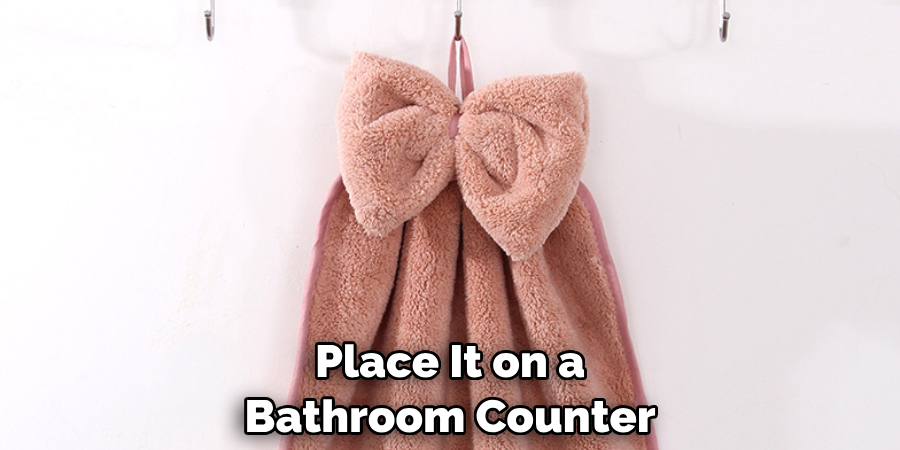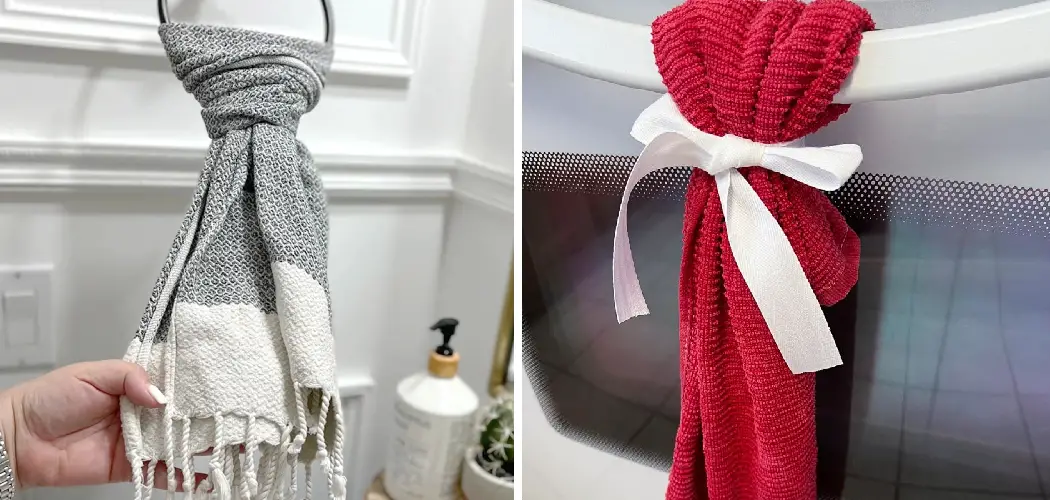Do you want to learn how to tie a hand towel? While it might seem like an insignificant task, tying your hand towel can make a significant impact on both the aesthetic appeal and functionality of your bathroom. Not only does it keep the area clean and organized, but it also adds fun flair to this otherwise mundane chore.

Whether you’re looking to upgrade your bathroom décor or simply need a tutorial on how to do something new, learning to tie a hand towel is worth mastering! In this blog post we’ll give you step-by-step instructions on everything from prepping and cleaning supplies needed for the job, all the way through completing that perfect ‘towel knot’– so let’s get started.
The Importance of a Well-Tied Hand Towel
Having a well-tied hand towel can be a great convenience in the kitchen or bathroom. It allows you to easily access and use towels without having them drag on the ground, and helps keep them organized and out of the way when not being used. A correctly tied hand towel also eliminates any potential messes that could come from dragging a loose towel across your counter or floor.
Having a clean, tidy towel helps add an extra layer of sanitation and can help keep your home looking neat and organized.
Tying a hand towel correctly also helps ensure it will last longer by preventing it from becoming overused and frayed at the edges. Additionally, having a well-tied hand towel ensures that any unwanted germs or bacteria won’t get transferred onto other surfaces or your hands. This helps keep the areas where you use the towel clean and safe for everyone in your home.
Overall, having a well-tied hand towel can be extremely beneficial. It can improve the tidiness of any area, help prevent unwanted germs or bacteria from transferring, and make it easier to grab a towel when needed without creating a mess. Follow the steps outlined above to tie your own hand towels correctly and enjoy all of these benefits!
Different Types and Materials of Hand Towels
Hand towels come in a variety of types and materials, so it’s important to choose the best one for the job you have in mind. Cotton is probably the most common material used for hand towels, but other options include microfiber, rayon, bamboo, hemp and even silk. Each has its own unique features when it comes to durability, absorbency and softness.

Cotton is an incredibly popular choice due to its affordability and versatility. It’s also very durable and can stand up to repeated washings without losing shape or color. Cotton hand towels are highly absorbent due to their thick fibers, making them ideal for kitchen use or general cleaning tasks around the home. They’re also quite soft on your skin, making them a comfortable option for after-shower use.
Microfiber is another material to consider when choosing a hand towel. This fabric is incredibly lightweight and dries quickly, making it ideal for travel or outdoors activities. It’s also highly absorbent, so you can use it to tackle just about any mess or spill without having to worry about moisture retention. Microfiber is also quite durable, so you can count on your hand towel to last for many uses.
Choosing the Right Hand Towel for Different Purposes
When selecting a hand towel for your needs, it’s important to consider the various types and their different uses. Cotton towels are soft, absorbent and durable, making them an excellent choice for most situations. Microfiber towels are softer than cotton but less absorbent and not as durable. They can be used for things like wiping glass or other surfaces that require a gentle touch.
Terry cloth towels are thicker and more absorbent than cotton but take longer to dry. They make great bath towels because they’re highly absorbent and also work well in the kitchen for cleaning up spills or scrubbing dishes. Finally, linen hand towels tend to have a luxurious feel, making them perfect for use in guest bathrooms or as decorative accents.
When tying a towel, it’s important to consider the type of fabric and how you want to use it. Cotton towels are easy to knot but may not be as secure as thicker fabrics like terry cloth or linen. Microfiber towels can also be tied securely but should be handled with greater care since they are more delicate.
Linen hand towels tend to look the most elegant when tied in a bow, making them ideal for guest bathrooms or decorative purposes. No matter which type of towel you choose, make sure that it is washed and dried properly before use to ensure its maximum absorbency.

10 Steps How to Tie a Hand Towel
Step 1: Choose the Right Towel
Select a hand towel that is suitable for tying. Look for a towel made of a soft and absorbent material, preferably with a smooth texture. Avoid towels with frayed edges or excessive wear and tear, as they may not hold up well when tied.
However, if the towel is too thick or plush, it may be difficult to tie effectively. Although there are many colors and styles of towels available, a plain white or light-colored towel works best for tying.
Step 2: Fold the Towel
Lay the towel flat on a clean surface. Fold the towel in half lengthwise, aligning the shorter edges. Smooth out any wrinkles or creases to ensure a neat and tidy appearance. If desired, you can use a ruler to make sure the crease is perfectly straight.
While holding the two edges together, fold the towel in half again so that it is now a quarter of its original size. Smooth out any wrinkles and creases and use a ruler to ensure the crease is straight. This creates a long, thin rectangle that is perfect for tying into a hand towel.
Step 3: Determine the Length of the Tail
Decide how long you want the tail of the towel to be. The tail refers to the portion of the towel that extends beyond the knot or bow. This will depend on your personal preference and the desired look. For a longer tail, leave more excess towel; for a shorter tail, leave less.
Step 4: Start the Knot or Bow
Pick up the folded towel from the center, holding both edges together. Bring the edges towards each other, forming a loop with the folded part of the towel at the top. This loop will serve as the foundation for the knot or bow.

Step 5: Create a Basic Knot
To create a simple basic knot, cross the left side of the towel over the right side. Pass the left side under the right side and pull it through the loop. Tighten the knot by pulling both ends of the towel in opposite directions. Adjust the tail length if needed.
Step 6: Tie a Decorative Bow
If you prefer a more decorative style, follow these steps to tie a bow instead. After creating the basic knot in step 5, take the left side of the towel and form a loop by bending it towards the right side. Hold the loop with your thumb and forefinger.
Step 7: Make the Second Loop
Next, take the right side of the towel and bring it over the loop created in step 6. Pass it under the loop and pull it through, forming a second loop. This loop will be the other half of the bow.
Step 8: Tighten the Bow
Hold onto the ends of the towel and gently pull them apart to tighten the bow. Adjust the loops and tails to ensure a symmetrical and visually pleasing bow shape. Fluff up the loops if necessary for a fuller appearance.
Step 9: Secure the Knot or Bow
To ensure the knot or bow stays in place, give it a final tightening. Check if any adjustments are needed to achieve the desired look. Smooth out any wrinkles or twists in the towel to maintain a neat appearance.
Step 10: Display or Use the Tied Towel
Once you’re satisfied with the knot or bow, decide how you want to use the tied towel. You can hang it over a towel rack, place it on a bathroom counter, or use it for decorative purposes. Remember to consider the functionality of the knot or bow if you plan to use the towel regularly.

Conclusion
Overall, learning how to tie a hand towel is an easy and simple task with many benefits. Not only does a neatly tied hand towel look aesthetically pleasing, it also keeps your towels tightly organized and ready to go for each use. We hope this guide served as a useful resource for you. Adopt the skill of tying a hand towel and give your bathroom set up an upgrade today.
Don’t forget to check out our additional blog posts on home organization to take your organizing skills to the next level. With some creativity, you could create beautiful ties and designs that will make visitors marvel over. Now get creative and start tying! It just takes a few minutes of practice for an incredible outcome, so don’t be afraid to try something more than once until you get it right.

